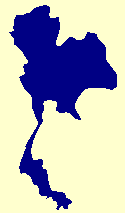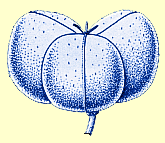
Flora of Thailand
Euphorbiaceae

 |
|
 |
The classification used follows G.L. Webster (Synopsis of the genera and suprageneric taxa of Euphorbiaceae, Ann. Missouri Bot. Gard. 81: 33-144. 1994) and A. Radcliffe-Smith (Genera Euphorbiacearum. 2001. Royal Botanic Gardens, Kew). For the subtribe Hippomaninae H.-J. Esser in Radcliffe-Smith was followed. The new genus Colobocarpos is classified in the tribe Codiaeae.
The characters and descriptions used to delimit the suprageneric entities in the Euphorbiaceae can be found in these two publications. They also comprise keys to the subfamilies up to genera. Because the descriptions and keys are very clear we will refrain from copying them here again and we only present the bare classification.
Recent molecular research suggests that the Euphorbiaceae in the sense of this flora should be split into five families. The present uni-ovulate subfamilies (Acalyphoideae, Crotonoideae and Euphorbioideae) will become the Euphorbiaceae in the strict sense, with the tribe Galearieae in the Aclyphoideae as family Pandaceae. The bi-ovulate subfamily Phyllanthoideae will become the Phyllanthaceae with the tribe Drypeteae as Putranjivaceae. And the other bi-ovulate subfamily Oldfieldioideae will become the Picrodendraceae. However, the phylogeny of the order Malphigiales is still far from satisfying, therefore, it is still possible that large parts of the Euphorbiaceae s.l. may come together again. For this reason we refrain from implementing these changes here and we leave the Euphorbiaceae in the broad sense as most people know them.
|
Subfamily |
Tribe |
Subtribe |
Genus |
New Family |
|
Phyllanthoideae |
|
|
|
Phyllanthaceae |
|
|
WIELANDIEAE |
|
|
|
|
|
BRIDELIEAE |
|
|
|
|
|
|
|
|
|
|
|
PHYLLANTHEAE |
Leptopinae |
|
|
|
|
|
|
|
|
|
|
|
Flueggeinae |
|
|
|
|
|
|
|
|
|
|
|
|
|
|
|
|
|
|
|
|
|
|
|
|
|
|
|
|
|
|
|
|
|
|
DRYPETEAE |
|
Putranjivaceae |
|
|
|
ANTIDESMEAE |
Scepinae |
|
|
|
|
|
|
|
|
|
|
|
Antidesminae |
|
|
|
|
HYMENOCARDIEAE |
|
|
|
|
|
BISCHOFIEAE |
|
|
|
|
|
|
|
|
|
|
Oldfieldioideae |
|
|
|
Picrodendraceae |
|
|
CLAETIEAE |
Dissilariinae |
|
|
|
|
|
|
|
|
|
Acalyphoideae |
|
|
|
Euphorbiaceae |
|
|
CHAETOCARPEAE |
|
Peraceae |
|
|
|
CHEILOSEAE |
|
|
|
|
|
ERISMANTHEAE |
|
|
|
|
|
GALEARIEAE |
|
Pandaceae |
|
|
|
|
|
|
|
|
|
AGROSTISTACHYDEAE |
|
|
|
|
|
|
|
|
|
|
|
CHROZOPHOREAE |
Doryxylinae |
|
|
|
|
|
|
|
|
|
|
|
|
|
|
|
|
|
Chrozophorinae |
|
|
|
|
PYCNOCOMEAE |
Blumeodendrinae |
|
|
|
|
|
|
|
|
|
|
|
|
|
|
|
|
EPIPRINEAE |
Epiprininae |
|
|
|
|
|
|
|
|
|
|
|
|
|
|
|
|
|
|
|
|
|
|
ALCHORNEAE |
Alchorninae |
|
|
|
|
ACALYPHEAE |
Ricininae |
|
|
|
|
|
Mercurialinae |
|
|
|
|
|
Cleidiinae |
|
|
|
|
|
|
|
|
|
|
|
|
|
|
|
|
|
Macaranginae |
|
|
|
|
|
Claoxylinae |
|
|
|
|
|
|
|
|
| Rottlerinae | Hancea | |||
|
|
|
|
|
|
|
|
|
Acalyphinae |
|
|
|
|
|
Lasiococcinae |
|
|
|
|
|
|
|
|
|
|
|
|
|
|
|
|
PLUKENETIEAE |
Plukenetiinaea |
|
|
|
|
|
Tragiinae |
|
|
|
|
|
|
|
|
|
|
|
|
|
|
|
|
|
Dalechampiinae |
|
|
|
|
OMPHALEAE |
|
|
|
|
|
|
|
|
|
|
Crotonoideae |
|
|
|
Euphorbiaceae |
|
|
MICRANREAE |
Heveinae |
|
|
|
|
MANIHOTEAE |
|
|
|
|
|
ADENOCLINEAE |
Endosperminae |
|
|
|
|
GELONIEAE |
|
|
|
|
|
ELATERIOSPERMEAE |
|
|
|
|
|
JATROPHEAE |
|
|
|
|
|
CODIAEAE |
|
|
|
|
|
|
|
|
|
|
|
|
|
|
|
|
|
|
|
|
|
|
|
|
|
|
|
|
|
|
|
|
|
|
|
|
|
|
|
|
|
|
|
Tritaxis |
|
|
|
TRIGONOSTEMONEAE |
|
|
|
|
|
CROTONEAE |
|
|
|
|
|
|
|
|
|
|
|
ALEURITIDEAE |
Aleuritinae |
|
|
|
|
|
|
|
|
|
|
|
|
|
|
|
Euphorbioideae |
|
|
|
Euphorbiaceae |
|
|
STOMATOCALYCEAE |
Stomatocalycinae |
|
|
|
|
HIPPOMANEAE |
Carumbiinae |
|
|
|
|
|
Hippomaninae |
|
|
|
|
|
|
|
|
|
|
|
|
|
|
|
|
|
|
|
|
|
|
|
|
|
|
|
|
|
|
|
|
|
|
HUREAE |
|
|
|
|
|
EUPHORBIEAE |
Euphorbiinae |
|
|
|
|
|
|
|